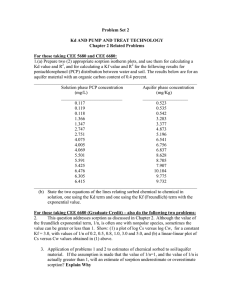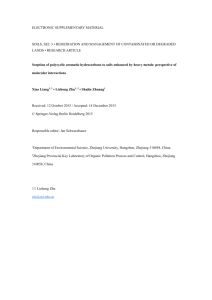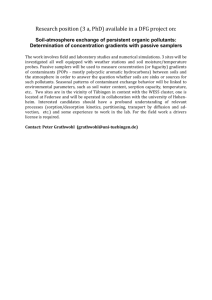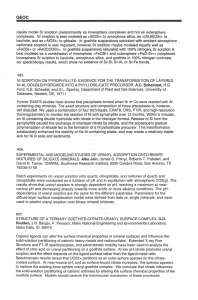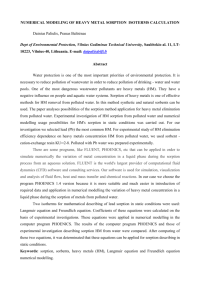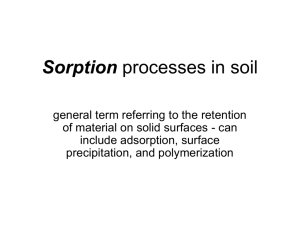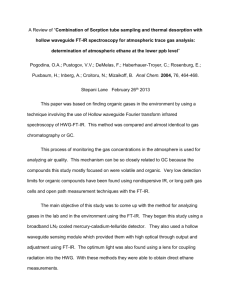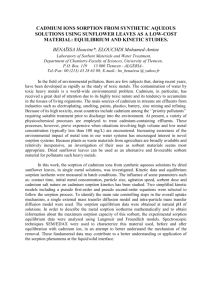Sorption of the Neutral and Charged Forms of Pentachlorophenol on... Evidence for Different Mechanisms
advertisement
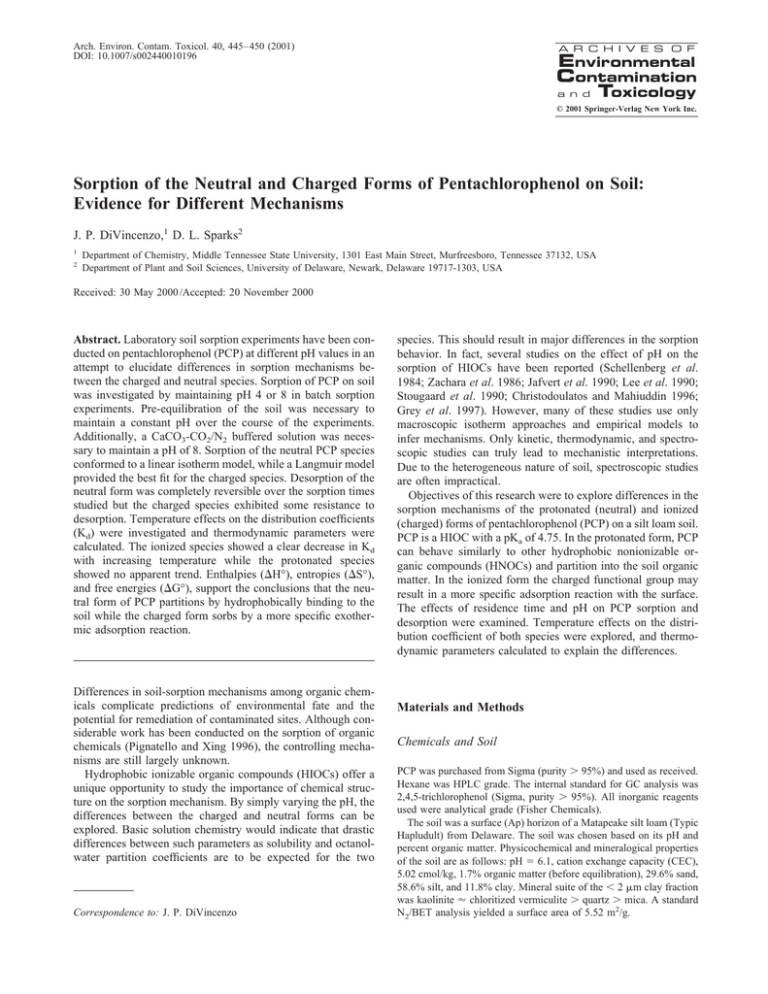
Arch. Environ. Contam. Toxicol. 40, 445– 450 (2001) DOI: 10.1007/s002440010196 A R C H I V E S O F Environmental Contamination a n d Toxicology © 2001 Springer-Verlag New York Inc. Sorption of the Neutral and Charged Forms of Pentachlorophenol on Soil: Evidence for Different Mechanisms J. P. DiVincenzo,1 D. L. Sparks2 1 2 Department of Chemistry, Middle Tennessee State University, 1301 East Main Street, Murfreesboro, Tennessee 37132, USA Department of Plant and Soil Sciences, University of Delaware, Newark, Delaware 19717-1303, USA Received: 30 May 2000 /Accepted: 20 November 2000 Abstract. Laboratory soil sorption experiments have been conducted on pentachlorophenol (PCP) at different pH values in an attempt to elucidate differences in sorption mechanisms between the charged and neutral species. Sorption of PCP on soil was investigated by maintaining pH 4 or 8 in batch sorption experiments. Pre-equilibration of the soil was necessary to maintain a constant pH over the course of the experiments. Additionally, a CaCO3-CO2/N2 buffered solution was necessary to maintain a pH of 8. Sorption of the neutral PCP species conformed to a linear isotherm model, while a Langmuir model provided the best fit for the charged species. Desorption of the neutral form was completely reversible over the sorption times studied but the charged species exhibited some resistance to desorption. Temperature effects on the distribution coefficients (Kd) were investigated and thermodynamic parameters were calculated. The ionized species showed a clear decrease in Kd with increasing temperature while the protonated species showed no apparent trend. Enthalpies (⌬H°), entropies (⌬S°), and free energies (⌬G°), support the conclusions that the neutral form of PCP partitions by hydrophobically binding to the soil while the charged form sorbs by a more specific exothermic adsorption reaction. Differences in soil-sorption mechanisms among organic chemicals complicate predictions of environmental fate and the potential for remediation of contaminated sites. Although considerable work has been conducted on the sorption of organic chemicals (Pignatello and Xing 1996), the controlling mechanisms are still largely unknown. Hydrophobic ionizable organic compounds (HIOCs) offer a unique opportunity to study the importance of chemical structure on the sorption mechanism. By simply varying the pH, the differences between the charged and neutral forms can be explored. Basic solution chemistry would indicate that drastic differences between such parameters as solubility and octanolwater partition coefficients are to be expected for the two Correspondence to: J. P. DiVincenzo species. This should result in major differences in the sorption behavior. In fact, several studies on the effect of pH on the sorption of HIOCs have been reported (Schellenberg et al. 1984; Zachara et al. 1986; Jafvert et al. 1990; Lee et al. 1990; Stougaard et al. 1990; Christodoulatos and Mahiuddin 1996; Grey et al. 1997). However, many of these studies use only macroscopic isotherm approaches and empirical models to infer mechanisms. Only kinetic, thermodynamic, and spectroscopic studies can truly lead to mechanistic interpretations. Due to the heterogeneous nature of soil, spectroscopic studies are often impractical. Objectives of this research were to explore differences in the sorption mechanisms of the protonated (neutral) and ionized (charged) forms of pentachlorophenol (PCP) on a silt loam soil. PCP is a HIOC with a pKa of 4.75. In the protonated form, PCP can behave similarly to other hydrophobic nonionizable organic compounds (HNOCs) and partition into the soil organic matter. In the ionized form the charged functional group may result in a more specific adsorption reaction with the surface. The effects of residence time and pH on PCP sorption and desorption were examined. Temperature effects on the distribution coefficient of both species were explored, and thermodynamic parameters calculated to explain the differences. Materials and Methods Chemicals and Soil PCP was purchased from Sigma (purity ⬎ 95%) and used as received. Hexane was HPLC grade. The internal standard for GC analysis was 2,4,5-trichlorophenol (Sigma, purity ⬎ 95%). All inorganic reagents used were analytical grade (Fisher Chemicals). The soil was a surface (Ap) horizon of a Matapeake silt loam (Typic Hapludult) from Delaware. The soil was chosen based on its pH and percent organic matter. Physicochemical and mineralogical properties of the soil are as follows: pH ⫽ 6.1, cation exchange capacity (CEC), 5.02 cmol/kg, 1.7% organic matter (before equilibration), 29.6% sand, 58.6% silt, and 11.8% clay. Mineral suite of the ⬍ 2 m clay fraction was kaolinite ⬇ chloritized vermiculite ⬎ quartz ⬎ mica. A standard N2/BET analysis yielded a surface area of 5.52 m2/g. 446 J. P. DiVicenzo and D. L. Sparks Equilibration of Soil Desorption Studies The natural soil pH is 6.1. Experiments were conducted at both pH 4 and pH 8 to compare the protonated and ionized forms of PCP. Due to the soil’s relatively high buffering capacity it was necessary to equilibrate the soil to the desired pH of the experiment. This would allow for a constant pH over the course of the entire experiment. Soil (20 g) was washed three times with a 250-ml solution (pH 4.0 or pH 8.0) of 0.01 M CaCl2, 0.02% NaN3 (bacteriological inhibitor) by shaking at 150 cycles/min in 250-ml plastic screw capped bottles for 24, 48, and 48 h. Samples were centrifuged in between washes for 20 min at 514 g. Soil was then oven-dried at 50°C for approximately 48 h and screened to pass through a U.S. standard No. 10 mesh (2 mm). A modification of the above procedure was necessary for the pH 8 studies. During the first wash it was necessary to repeatedly spike the suspensions with 4 M NaOH. This was done every few hours over the course of 10 h until the pH was stabilized at 8.0. The washing procedure was then carried out identical to that described above. Equilibration of soil also serves as a washing step to help remove nonsettling microparticles and dissolved organic matter, which have been implicated in the solids concentration effect (O’Connor and Connolly 1980; Voice and Weber 1985; Mackay and Powers 1987). Mixing at a faster speed (150 cycles/min) and centrifuging at a slower speed (514 g) than is used for the sorption and desorption studies (50 rpm, 6,315 g) helps increase the washing efficiency (Gschwend and Wu 1985). The supernatant of the washing solutions was analyzed for organic carbon content after each wash. This was done on a Beckman-Eastman 915B total organic carbon (TOC) analyzer. Desorption studies were conducted on samples that had sorbed PCP for varying amounts of time. The concentration of PCP (5– 6 mg/L) was similar for both species. After sorption, 80% of the solution volume was removed (20 ml) and replaced with PCP-free solution at the same pH as the original sorption experiments. Samples were then placed back on the orbital shaker at 50 rpm for 2 days. Tubes were removed from the shaker after 2 days. Aliquots of the supernatant were then collected over time. Aqueous samples were separated and stored. Five replicates were used at each time interval. Controls (no soil or no PCP) comprised 17% of all the samples. Sorption Studies Loss of PCP over the course of the experiments was negligible, with the controls (no soil) containing 99% of the original PCP concentration. Soil extraction with hot methanol (DiVincenzo 1996) recovered greater than 95% of the initial PCP concentrations. An experiment designed to study mixing showed that mixing beyond 2 days had no effect on sorption (results not shown). The pH 4 studies used a 0.01 M CaCl2, 0.02% NaN3 solution adjusted with 3 M HCl to a pH of 4.0. Preliminary studies demonstrated that a pH of 8 was not maintainable even with the equilibrated soil. For these studies a CaCO3-CO2/N2 buffered solution was prepared. A 10⫺3 M CaCO3, 0.02% NaN3 solution was stirred for several hours with a CO2/N2 gas mixture bubbling through the solution. This was continued until the system came to equilibrium as determined by a stable pH. N2 was then bubbled through to adjust the pH to 8.0. Solution was filtered through Whatman 42 filter paper to remove undissolved CaCO3. Glass centrifuge tubes (25 ml) with Teflon威-lined screw caps were filled with either 1.00 or 2.00 g of soil (determined to be appropriate in previous experiments) and 24.9 ml of PCP solution and placed on an orbital shaker at 50 rpm in the dark (to prevent photolysis) at 25 ⫾ 1°C, for a minimum of 48 h. In all experiments there was a minimum of 20% of the samples used as controls (no soil or no PCP). Samples were collected and centrifuged at 6,315 g for 15 min. A portion of the aqueous phase was stored for analysis. Particle degradation was shown to be negligible as determined by N2/BET analysis before and after mixing (before 5.52 ⫾ 0.41 m2/g, after 5.60 ⫾ 0.52 m2/g). Any percent difference in surface area was less than the inherent error of the BET analysis. Temperature Studies Temperature studies were carried out identically to other sorption studies. Temperature control chambers and rooms were used to maintain constant temperatures at 4, 25, and 55°C. All samples were equilibrated for 5 days. Seven replicates were used at each data point, and the initial concentrations for all samples were less than 5.5 mg/L. Analysis All aliquots of samples were acidified and extracted with hexane using standard liquid-liquid extraction procedures. UV spectrophotometric analysis showed no detectable amount of PCP remaining in the aqueous phase. Each sample was injected twice into a gas chromatograph equipped with a mass spectrometer (MS) detector. The observation was made that MS analysis was most consistent within the concentration range of 0.5–2.5 mg/L of PCP. Therefore, an attempt was made to have all the samples analyzed within this concentration range in order to reduce error. The integrity of the chromatography (the nonexistence of any aberrant peaks) and the recoverability of 95% of the PCP after 100 days suggested the absence of degradation. Results and Discussion Sorption Kinetics Preliminary studies indicated that the initial rapid kinetics for both species were similar with an “apparent equilibrium” reached in approximately 48 h. The distribution coefficient (Kd) at the 2-day “apparent equilibrium” for the ionized form (at pH 8 no appreciable amount of PCP is in the protonated form) was 5 L/kg and 109 L/kg for the protonated form (taking into account the fraction of PCP that is ionized at pH 4.1). We previously reported that the slow sorption stage (sorption beyond 48 h) of the protonated form of PCP is concentration dependent (DiVincenzo and Sparks 1997). As a purely qualitative description, if we consider a simple two-site series model in which sorption takes place into site 1 (apparent equilibrium) and diffusion occurs from site 1 into site 2 (slow sorption), then it is the concentration in site 1 that is important in controlling the slow sorption stage (Brusseau et al. 1991). To compare accurately the slow sorption kinetics for the two species, the concentrations in site 1 after 48 h must be similar. A kinetics experiment was conducted in which the initial PCP concentration was substantially higher (19.8 mg/L) for the ionized species compared to the protonated species (5.1 mg/L). Neutral and Charged Pentachlorophenol in Soil This resulted in sorbed concentrations after 48 h (“apparent equilibrium”), into site 1, which were comparable. Results are shown in Figure 1 as the change in the sorbed fraction (S/C) with time, where S is the sorbed concentration (mg/kg) and C is the aqueous concentration (mg/L). Each point is the average of two replicates. There is no statistically significant change in S/C for the ionized species at 21 days of sorption (95% CI), when compared to 2 days of sorption. The protonated form shows a significant change at 14 days of sorption. This was determined by a comparison of means between the seven replicates at 3.6 days and the two replicates at 14.1 days. A 95% confidence interval was used. This experiment allows a slow kinetics comparison, which eliminates a possible concentration bias. It suggests that any differences in the slow sorption stage between the protonated and ionized forms is a result of something other than a concentration gradient created by differences in the extent of sorption into site 1. For some other reason, it appears that the slow sorption of the ionized species is inhibited in some way. One concern was that the initial equilibration of the soil at pH 8 would dissolve a substantially greater fraction of soil organic matter (SOM) when compared to the pH 4 equilibration. If SOM is the major sorbing medium, then certainly the overall sorption will be reduced. However, more importantly, this might explain why the slow sorption stage was not present at pH 8. To address this concern we analyzed the supernatant of the washing solutions for organic carbon (OC) content after each wash. The pH 8 solution removed twice as much organic carbon (14.2%) from the soil than the pH 4 wash did (7.1%). However, this difference of 7.1% would not be significant enough to reduce the slow sorption stage substantially. In independent studies (data not shown), even when 63% of the SOM was oxidized using hydrogen peroxide, a significant slow sorption stage for the protonated species after 14 days was still detectable. Ball and Roberts (1991) have shown intraorganic matter diffusion to be significant even for aquifer solids of less than 0.1% organic carbon. Sorption Isotherms At this point it appears that the ionized form of PCP does not exhibit a pronounced slow sorption stage when compared to the protonated species. It might either be repelled by the negatively charged SOM or clay surfaces (Hamaker and Thompson 1972; Banerji et al. 1986), has a different slow sorption mechanism, and/or reacts more specifically with the surface resulting in a hindrance of the slow sorption stage. To explore the third possibility we conducted comparative sorption isotherm experiments at pH 4 and 8. Figure 2 shows the two isotherms at the two pH values. These samples were equilibrated for 6 days and therefore do not represent any significant slow sorption. Each point is the average of three replicates. Error bars representing standard deviations of the sorbed concentration (maximum standard deviation for all samples ⫽ 9.9) are too small to be seen. The pH 8 isotherm is nonlinear (r2 ⫽ 0.879, relative standard deviation of slope [RSD] ⫽ 16.6%) when compared to the linear isotherm (r2 ⫽ 0.993, RSD ⫽ 5.6%) at pH 4. We previously showed that the sorption of the protonated form on this soil was linear out close 447 Fig. 1. Sorption kinetics of pentachlorophenol on soil at a pH of 4.1 and 7.9. Depicted as the rate of increase in the sorbed fraction (S/C) with time. The line of “apparent equilibrium” is for the pH 4.1 data Fig. 2. PCP sorption isotherms at pH 4.1 and 7.9. The data for pH 4.1 was fit with the linear sorption model and the data for pH 7.9 was fit with the Langmuir model to the solubility limit (DiVincenzo and Sparks 1997). This might suggest a partitioning mechanism into the SOM. These isotherm differences between the two species might suggest a difference in the rapid sorption mechanism that can be attributed to the ionized form reacting more specifically with the surface when compared to the protonated form. This more specific association with the surface could result in a hindrance of the PCP when it attempts to diffuse to sites deeper within the soil matrix. Furthermore, because we are speculating that the mechanism for the ionized species is adsorption, we can calculate the sorption maximum using the nonlinear Langmuir model. The nonlinear Freundlich model was unable to describe the latter data points, as it does not predict a sorption maximum. The Langmuir equation yielded a sorption maximum of 250 mg/kg (RSD ⫽ 2.5%), which is well below the maximum amount sorbed at pH 4. This suggests that there might be a limited number of sites available and a more specific adsorption reaction may be taking place. Stapleton et al. (1994) found similar differences between the two PCP species for sorption onto HDTMA modified clay. Ehrlich and Huang (1993) found linear sorption of chlorophenols onto a soil (6.9% SOM) and nonlinear Langmuir sorption onto kaolinite. 448 J. P. DiVicenzo and D. L. Sparks Desorption Studies With increasing sorption time, both species of PCP showed a decrease in the amount desorbed. When the sorption time was increased from 2 to 21 days, the percentage desorbed after 2 days decreased from 95% to 68% and 86% to 49% for the protonated and ionized species, respectively. This effect has been reported repeatedly in the literature (Pignatello and Xing 1996). However, the mechanism causing this might differ for the two species. When desorption times for the 21-day samples were increased from 2 to 8 days, the percentage desorbed for the protonated species increased to 94%. This might imply that the PCP needs time to diffuse out of the soil matrix. Banerji et al. (1986) found PCP sorption to be nearly completely reversible at lower pH values. The ionized form (pH 7.9) of PCP showed only 50% desorption. This form of PCP may be more strongly sorbed to the surface and is therefore resistant to desorption. Isaacson and Frink (1984) found some chlorophenols to have specific sorbate-sorbent interactions resulting in sorption irreversibility, but did not closely monitor the pH. Temperature Studies One way to help elucidate sorption mechanisms is to calculate thermodynamic parameters. This can be accomplished by measuring the sorption as a function of temperature. There are several instances in the literature where this approach is utilized for sorption of organic compounds on soil surfaces (Moreale and Bladel 1979; Horzempa and Di Toro 1983; Curl and Keolelan 1984; McCloskey and Bayer 1987; Cancela et al. 1992; Goss 1992; Ehrlich and Huang 1993; Piatt et al. 1996; Severtson and Banerjee 1996; Brucher and Bergstrom 1997). Depending on the sorbate and the sorbent studied, an increase in Kd with increasing temperature can be expected (Moreale and Bladel 1979; Di Toro and Horzempa 1982; Curl and Keolelan 1984; McCloskey and Bayer 1987; Brucher and Bergstrom 1997) or a decrease in Kd with increasing temperature (McCloskey and Bayer 1987; Piatt et al. 1996; Severtson and Banerjee 1996; Brucher and Bergstrom 1997). Using the following standard thermodynamic equations one can calculate enthalpies, entropies, and free energies. ln Kd ⫽ ⫺⌬H⬚sorp ⫹ constant RT (Eq. 1) ⌬G°⫽RT ln Kd (Eq. 2) ⌬G⬚ ⫽ ⌬H° ⫺ T⌬S° (Eq. 3) ° Here, ⌬Hsorp is the heat of sorption, ⌬G° is the free energy, ⌬S° is the entropy, R is the gas law constant, and T is the absolute temperature. Equation 1 shows that if the heat of sorption is independent of temperature, one should obtain a straight line when graphing ln Kd as a function of 1/T. Figure 3 shows the results as the change in Kd as a function of temperature. Error bars represent one standard deviation. Data for the protonated species shows no apparent trend and it has substantially more scatter (confirmed by F-test) than the Fig. 3. Temperature dependency plots for the sorption of pentachlorophenol on soil at pH values of 4.3 and 7.5. Error bars represent one standard deviation data for the ionized species. Mehrian et al. (1991) suggested that hydrophobic interactions might not be independent of temperature. This could also be a result of temperature effects on solubility and ionization constants. Small changes in either of these would affect the distribution coefficient. At the higher pH, the solubility of PCP is approximately two orders of magnitude greater, and we are roughly three orders of magnitude above the pKa. Small changes in either of these would not substantially affect Kd. The ionized species shows a clear decrease in Kd with increasing temperature (correlation coefficient ⫽ 0.99). Although it was shown that the ionized form of PCP conforms to a nonlinear isotherm, the initial concentration used for the temperature studies was well within the linear range of the isotherm. Table 1 shows the results using the above equations. The calculated ⌬G° and ⌬S° values are shown with plus or minus one standard deviation. Statistical analysis using a t-test with unequal variances confirms that all ⌬G° and ⌬S° values at pH 4.3 are statistically different (95% confidence) than their corresponding pH 7.5 values at the same temperature. The magnitude of ⌬H° suggests a weak type of bonding. However, the value for the ionized species (pH 7.5) is four times the value of the protonated species. These values agree well with other parameters found in the literature for chlorophenols. Severtson and Banerjee (1996) calculated values of ⫺1.8 kcal/mol and ⫺2.6 kcal/mol for 2,4-dichlorophenol (2,4-DCP) and 2,4-5trichlorophenol (2,4,5-TCP), respectively, on wood pulp at pH 4.00. Ehrlich and Huang (1993) found a range of ⫾ 0.5 kcal/mol for 2,4-DCP and 2,4,5-TCP on soil and kaolinite. The standard free energy change, ⌬G°, is negative for both species, as would be expected for product-favored reactions. However, they show opposite trends. ⌬G° for the ionized species decreases (becomes less negative) with increasing temperature. The protonated species shows an increase in ⌬G° with increasing temperature. The entropy values for both species are constant over the temperature range as would be expected. However, once again they show distinct differences. ⌬S° for the protonated species is positive, whereas it is negative for the ionized species. The positive entropy value for the protonated species may suggest an entropy-driven process. Hydrophobic bonding, the Neutral and Charged Pentachlorophenol in Soil 449 Table 1. Calculated thermodynamic quantities for the protonated and ionized species of pentachlorophenol (PCP) Quantity Temperature (K) pH 7.5 (kcal/mol)a pH 4.3 (kcal/mol)a ⌬H° ⌬G° ⌬G° ⌬G° ⌬S° ⌬S° ⌬S° 279–329 279 298 329 279 298 329 ⫺2.2 ⫺1.1 ⫾ 0.11 ⫺1.0 ⫾ 0.06 ⫺0.87 ⫾ 0.16 ⫺0.0041 ⫾ 0.00041 ⫺0.0040 ⫾ 0.00024 ⫺0.0042 ⫾ 0.00077 ⫺0.50 ⫺2.4 ⫾ 0.27 ⫺2.7 ⫾ 0.12 ⫺2.8 ⫾ 0.23 0.0062 ⫾ 0.00070 0.0072 ⫾ 0.00032 0.0070 ⫾ 0.00058 a Plus-minus values represent one standard deviation. most common mechanism attributed to sorption of HNOCs onto soil surfaces, is an entropy driven process (Hassett and Banwart 1989). The positive entropy comes from the loss of the structured water surrounding the sorbate. This tendency for hydrophobic bonding will typically increase with increasing temperature (Hamaker and Thompson 1972). This is demonstrated by the increase in ⌬G° with increasing temperature. The decrease in ⌬G° with increasing temperature, for the ionized species, is consistent with an exothermic adsorption process. An exothermic reaction becomes less and less favorable as the temperature is increased. This yields a negative entropy due to the loss of freedom as the molecules adsorb to the surface. These results suggest a more specific surface reaction as a consequence of the presence of the charged functional group. Some possibilities might be hydrogen bonding, charge transfer, ion exchange, and ligand exchange (Shimizu et al. 1992). However, considering the magnitude of the enthalpy, ion exchange can be eliminated, and hydrogen bonding (Goss 1992) and charge transfer (Hamaker and Thompson 1972) are the most likely candidates. Although the heat of sorption is small, one study that was not conducted was to look at the change in thermodynamic parameters over time. This may provide interesting results and help elucidate the slow soil binding mechanism. Summary Sorption-desorption data and thermodynamic calculations suggest that there are distinct differences in the soil-sorption mechanisms for the charged and neutral forms of pentachlorophenol. The charged form follows a Langmuir-type sorption and shows some resistance to desorption. Thermodynamic calculations suggest an exothermic adsorption reaction. The neutral form follows a linear sorption and shows fairly complete reversibility. This suggests a partitioning mechanism and is supported by thermodynamic calculations demonstrating an entropy-driven hydrophobic binding process. This research adds to the growing body of knowledge that sorption mechanisms for ionizable organic compounds vary with pH (sorbing species). Furthermore, thermodynamic data supports the macroscopic observations, and this information may aid both in predicting environmental fate and in developing remediation strategies for these compounds. Acknowledgments. We would like to thank Douglas R. Ware for laboratory assistance. We would also like to thank both Middle Tennessee State University and the University of Delaware for financial support. References Ball WP, Roberts PV (1991) Long-term sorption of halogenated organic chemicals by aquifer material. 2. Intraparticle diffusion. Environ Sci Technol 25(7):1223–1236 Banerji KS, Piontek K, O’Connor JT (1986) Pentachlorophenol adsorption on soils and its potential for migration into ground water. In: Hazardous and industrial solid waste testing and disposal. ASTM, STP 933, vol 6, pp 120 –139 Brucher J, Bergstrom L (1997) Temperature dependence of linuron sorption to three different agricultural soils. J Environ Qual 26(5): 1327–1335 Brusseau ML, Jessup RE, Rao PSC (1991) Nonequilibrium sorption of organic chemicals: elucidation of rate-limiting processes. Environ Sci Technol 25(1):134 –142 Cancela GD, Taboada ER, Sanchez-Rasero F (1992) Carbendazim adsorption on montmorillonite, peat and soil. J Soil Sci 4399 –111 Christodoulatos C, Mahiuddin M (1996) Generalized models for prediction of pentachlorophenol adsorption by natural soils. Water Environ Res 68(3):370 –378 Curl RL, Keolelan GA (1984) Implicit-adsorbate model for apparent anomalies with organic adsorption on natural adsorbents. Environ Sci Technol 18(2):916 –922 Di Toro DM, Horzempa LM (1982) Reversible and resistant components of PCB adsorption-desorption: isotherms. Environ Sci Technol 16(9):594 – 602 DiVincenzo JP (1996) Slow sorption kinetics of pentachlorophenol on soil. Ph.D. diss., University of Delaware, Newark, DE DiVincenzo JP, Sparks DL (1997) Slow sorption kinetics of pentachlorophenol on soil: concentration effects. Environ Sci Technol 31(4):977–983 Ehrlich RS, Huang CP (1993) Adsorption of chlorophenols onto soil and kaolinite: effects of the properties of adsorbent and adsorbate. J Chin Inst Environ Eng 3(2):143–152 Goss K (1992) Effects of temperature and relative humidity on the sorption of organic vapors on quartz sand. Environ Sci Technol 26(11):2287–2294 Grey TL, Walker RH, Wehtje GR, Hancock HG (1997) Sulfentrazone adsorption and mobility as affected by soil and pH. Weed Sci 45:733–738 Gschwend PM, Wu S (1985) On the constancy of sediment-water partition coefficients of hydrophobic organic pollutants. Environ Sci Technol 19(1):90 –96 Hamaker JW, Thompson JM (1972) Adsorption. In: Goring C, Hamaker J (eds) Organic chemicals in the soil environment. Marcel Dekker, New York, NY, pp 49 –144 Hassett JJ, Banwart WL (1989) The sorption of nonpolar organics by soils and sediments. In: Sawhney B, Brown K (eds) Reactions and movement of organic chemicals in soils. Soil Science Society of America, Madison, WI, pp 31– 44 Horzempa LM, Di Toro DM (1983) The extent of reversibility of polychlorinated biphenyl adsorption. Water Res 17(8):851– 859 Isaacson PJ, Frink CR (1984) Nonreversible sorption of phenolic compounds by sediment fractions: the role of sediment organic matter. Environ Sci Technol 18(1):43– 48 Jafvert CT, Westall JC, Grieder E, Schwarzenbach RP (1990) Distribution of hydrophobic ionogenic organic compounds between octanol and water: organic acids. Environ Sci Technol 24(12): 1795–1803 450 Lee LS, Rao PSC, Nkedi-Kizza P, Delfino JJ (1990) Influence of solvent and sorbent characteristics on distribution of pentachlorophenol in octanol-water and soil-water systems. Environ Sci Technol 24(5):654 – 661 Mackay D, Powers B (1987) Sorption of hydrophobic chemicals from water: a hypothesis for the mechanism of the particle concentration effect. Chemosphere 16(4):745–757 McCloskey WB, Bayer DE (1987) Thermodynamics of fluridone adsorption and desorption on three California soils. Soil Sci Soc Am J 51:605– 612 Mehrian T, de Keizer A, Lyklema J (1991) Effect of temperature on the adsorption of organic cations on charged surfaces. Langmuir 7:3094 –3098 Moreale A, Bladel RV (1979) Soil interactions of herbicide-derived aniline residues: a thermodynamic approach. Soil Sci 127(1):1–9 O’Connor DJ, Connolly JP (1980) The effect of concentration of adsorbing solids on the partition coefficient. Water Res 141517– 1523 Piatt JJ, Backhus DA, Capel PD, Eisenreich SJ (1996) Temperaturedependent sorption of naphthalene, phenanthrene, and pyrene to low organic carbon sediments. Environ Sci Technol 30(3):751–760 Pignatello JJ, Xing B (1996) Mechanisms of the slow sorption of J. P. DiVicenzo and D. L. Sparks organic chemicals to natural particles. Environ Sci Technol 30(1): 1–11 Schellenberg K, Leuenberger C, Schwarzenbach RP (1984) Sorption of chlorinated phenols by natural sediments and aquifer materials. Environ Sci Technol 18(18):652– 657 Severtson SJ, Banerjee S (1996) Sorption of chlorophenols to wood pulp. Environ Sci Technol 30(6):1961–1969 Shimizu Y, Yamazaki S, Terashima Y (1992) Sorption of anionic pentachlorophenol (PCP) in aquatic environments: the effect of pH. Wat Sci Tech 25(11):41– 48 Stapleton MG, Sparks DL, Dentel SK (1994) Sorption of pentachlorophenol to HDTMA-clay as a function of ionic strength and pH. Environ Sci Technol 28(3):2330 –2335 Stougaard RN, Shea PJ, Martin AR (1990) Effect of soil type and pH on adsorption, mobility, and efficacy of imazaquin and imazethapyr. Weed Sci 38:67–73 Voice TC, Weber WJ (1985) Sorbent concentration effects in liquid/ solid partitioning. Environ Sci Technol 19(9):789 –796 Zachara JM, Ainsworth CC, Felice LJ, Resch CT (1986) Quinoline sorption to subsurface materials: role of pH and retention of the organic cation. Environ Sci Technol 20(6):620 – 627
